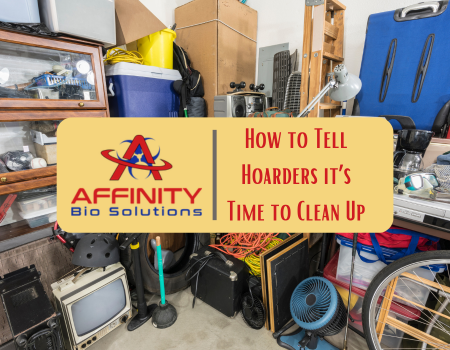Hoarders, individuals who accumulate and struggle to part with excessive amounts of belongings, often face significant challenges in maintaining a safe and healthy living environment. As friends, family members, or concerned individuals, broaching the topic of cleaning up with a hoarder requires sensitivity, empathy, and understanding. While it may be a difficult conversation to initiate, it’s crucial for the well-being of the hoarder and those around them. Here are some compassionate approaches to help navigate this delicate situation:
How to Tell Hoarders it’s Time to Clean Up
 Establish Trust and Understanding:
Establish Trust and Understanding:
Before addressing the issue of cleanup, take the time to build a trusting relationship with the hoarder. Listen to their concerns, fears, and anxieties without judgment. Seek to understand the underlying reasons behind their hoarding behavior, which could range from emotional attachments to past traumas or anxiety disorders.
- Choose the Right Timing:
Timing is key when initiating a conversation about cleanup. Avoid confronting the hoarder during moments of heightened stress or emotional distress. Instead, choose a calm and private setting where you can have an open and honest dialogue without interruptions.
- Express Concern and Empathy:
Approach the conversation with empathy and concern for the hoarder’s well-being. Express how their living situation may be impacting their health, safety, and quality of life. Use “I” statements to convey your feelings without placing blame or criticism.
- Focus on Health and Safety:
Highlight the importance of maintaining a clean and organized living space for health and safety reasons. Discuss potential hazards such as fire risks, mold growth, pest infestations, and difficulty accessing emergency exits. Emphasize that cleaning up is not about getting rid of cherished possessions but ensuring a safe environment for everyone.
- Offer Support and Assistance:
Let the hoarder know that they’re not alone in this process and that you’re there to support them every step of the way. Offer practical assistance, such as helping to sort through belongings, arranging for professional cleaning services, or connecting them with support groups or mental health professionals who specialize in hoarding disorder.
- Set Realistic Goals and Boundaries:
Break down the cleanup process into manageable steps and set realistic goals together. Avoid overwhelming the hoarder with unrealistic expectations or timelines. Respect their autonomy and decision-making process, while gently encouraging progress towards a cleaner and safer living environment.
- Provide Continued Encouragement and Follow-Up:
Cleaning up a hoarder’s living space is often a gradual and ongoing process that requires patience and persistence. Offer continued encouragement and support as they work towards their goals. Check in regularly to see how they’re coping and offer assistance or resources as needed.
- Respect Their Limits and Boundaries:
Recognize that hoarding is a complex and deeply ingrained behavior that may not be easily overcome. Respect the hoarder’s limits and boundaries, and avoid pressuring them into decisions or actions they’re not comfortable with. Encourage small victories and celebrate progress, no matter how incremental.
In conclusion, addressing the issue of cleaning up with a hoarder requires empathy, patience, and understanding. By approaching the conversation with care and sensitivity, you can help empower the hoarder to take positive steps towards creating a safer and healthier living environment. Remember to prioritize their emotional well-being and offer ongoing support throughout the cleanup process.

